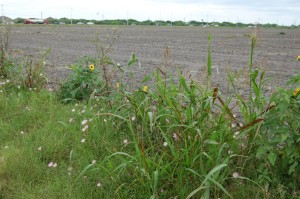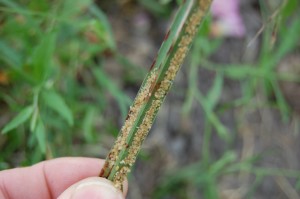by Robert Bowling, Stephen Biles, Danielle Sekula-Ortiz, and Kate Harrell
Sugarcane Aphid Update: As February was fading into the sunset abundant sugarcane aphid (SCA) populations were observed on volunteer and ratoon sorghum in south Texas. Their early population increase was attributed to unseasonably warm and dry conditions in January and February. There was concern around the possibility of early season SCA outbreaks on south TX sorghum if unseasonably warm conditions persisted.
Fortunately, a change in weather patterns brought rain and cooler conditions in March. Recent surveys of SCA on volunteer and ratoon sorghum along the Coastal Bend of Texas suggest that their populations have declined. However, they can still be found SCA on Johnsongrass is difficult to find. Dry conditions through the winter months allowed for maintenance of roadside areas and the combination of events Johnsongrass regrowth until recent rain events. The lack of Johnsongrass top growth in the winter may have been responsible for small SCA populations on this alternate host. Conversely, one year ago frequent heavy rain events prevented roadside and production field maintenance and Johnsongrass and volunteer/ratoon sorghum provided excellent overwintering hosts for SCA.

Johnsongrass bordering a recently cultivated production field. Johnsongrass is a year-round host of sugarcane aphid.
So, where does that leave us for the current season? It is difficult to predict SCA outbreaks but, with the recent warming trend, look for SCA populations to increase on overwintering hosts. Also, SCA infestations in Tamaulipas (Mexico) and the Rio Grande Valley will provide some indication of potential movement into sorghum growing in the Coastal Bend and Wintergarden regions of Texas. Currently, SCA populations in the Valley are increasing on winter hosts and small SCA colonies have been reported on sorghum in some fields.
Remember, insecticide seed treatments will provide early season plant protection from the SCA. How long should I expect insecticide seed treatments to provide early protection against SCA? Longevity of these products will vary from season-to-season and from one field to another. A reasonable expectation for residual activity of most insecticide seed treatments is about 30 days but they may be active for up to 50 days. It is advisable to start checking SCA on sorghum three to four weeks after planting if the seed was treated with an insecticide.
Will hybrids earmarked as ‘highly tolerant’ be immune to SCA infestations? There is much to learn about SCA resistance (often referred to as tolerance) in sorghum. Hybrids that have been deemed as ‘highly tolerant’ may become infested with economic levels of SCA. A good rule of thumb is to treat each field as though it were susceptible to SCA and scout all sorghum on a regular basis. A better understanding of SCA resistance in sorghum and, possibly, new sources of resistance may be identified by seasons end.
Insecticide applications will be an important tactic to manage economic populations of SCA on sorghum. The EPA ruling on the Section 18 request for Transform is forthcoming. Until then, Sivanto is the only registered product that provides consistent suppression of SCA. The Section 18 for Transform will be reported once EPA announces their decision.
This is the time to initiate detection monitoring in sorghum in south TX, especially in early seeded fields. Take some time to monitor SCA on Johnsongrass neighboring sorghum field borders. These populations frequently move to plants on the edges of sorghum fields. Take note of predator and parasite activity. They will be important as a limiting factor for SCA population growth. Eliminate volunteer and ratoon sorghum from production fields, even if the fields are fallowed. They serve as a reservoir for the sugarcane aphid.

Sugarcane aphid overwintering on Johnsongrass. This plant was on the edge of a production field. The overwintering aphids serve as a reservoir to infest sorghum during the production season. Cleaning up Johnsongrass along field edges may help reduce SCA populations.
Remember, this aphid is easily managed in sorghum with careful and frequent monitoring and timely insecticide applications. When should I consider spraying SCA in my fields? The economic threshold is 50 to 125 aphids per leaf. For detailed instructions on detection and scouting please refer to the sugarcane aphid scouting card. Thus card can be picked up at your local Extension office or downloaded from our website (http://ccag.tamu.edu/files/2015/05/ScoutCard.pdf).
